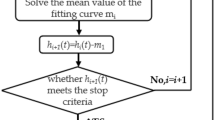Abstract
In the previous study, the inverse perturbation method was used to identify structural damages. Because all unmeasured DOFs were considered as unknown variables, considerable computational effort was required to obtain reliable results. Thus, in the present study, a system condensation method is used to transform the unmeasured DOFs into the measured DOFs, which eliminates the remaining unmeasured DOFs to improve computational efficiency. However, there may still arise a numerically ill-conditioned problem, if the system condensation is not adequate for numerical programming or if the system condensation is not recalibrated with respect to the structural changes. This numerical problem is resolved in the present study by adopting more accurate accelerated improved reduced system (AIRS) as well as by updating the transformation matrix at every step. The criterion on the required accuracy of the condensation method is also proposed. Finally, numerical verification results of the present accelerated inverse perturbation method (AIPM) are presented.
Similar content being viewed by others
References
Chen, J. C. and Garba, J. A., 1988, “On-Orbit Damage Assessment for Large Space Structures,”AIAA Journal, pp. 1119–1126.
Cho, K., Shin, J. and Lee, U., 2002, “Experimental Verification of the Str-uctural Damage Identification Method Developed for Beam Structures,”Transactions of the Korean Society of Mechanical Engineers A, Vol. 26, No. 12. pp. 2574–2580.
Choi, Y. J., 2001, “System Reduction and Selection of Degrees of Freedom in Structural Dynamic Inverse Problems.”Ph. D. Thesis, Inha University, Incheon, Korea.
Doebling, S. W., Farrar, C. R., Prime, M. B. and Shevitz, D. W., 1996, “Damage Identification and Health Monitoring of Structural and Mechanical Systems from Changes in Their Vibration Characteristics: A Literature Review,”Los Alamos National Report LA-13070-MS.
Doebling, S. W., 1996, “Minimum-Rank Optimal Update of Elemental Stiffness Parameters for Structural Damage Identification,”AIAA Journal, Vol. 34, No. 12, pp. 2615–2621.
Farrar, C. R. and Doebling, S. W., 1997, “An Overview of Modal-Based Damage Identification Methods,”Proceeding of DAMAS Conference, Sheffield, UK.
Gafka, G. K. and Zimmerman, D. C, 1996, “Structural Damage Detection via Least Squares Dynamic Residual Force Minimization with Quadratic Measurement Error Inequality Constraint (LSQIC*),” 14thIMAC, pp. 1278–1284.
Guyan, R. J., 1965, “Reduction of Stiffness and Mass Matrices,”AIAA Journal, Vol. 3, pp. 380.
Kammer, D. C., 1988. “Optimum Approximation for Residual Stiffness in Linear System Identification,”AIAA Journal, Vol. 26, No. 1, pp. 104–112.
Kaouk, M. and Zimmerman, D. C., “Structural Damage Assessment Using a Generalized Minimum Rank Perturbation Theory.”AIAA Journal, Vol. 32, No. 4, 1994, pp. 836–842.
Kim, K. O. and Kang, M. K., 2001, “Convergence Acceleration of Iterative Modal Reduction Methods,”AIAA Journal, Vol. 39, No. I, pp. 134–140.
Lee, U. and Shin, J., 2002, “A Frequency Response Function-Based Structural Damage Identification Method,”Computers & Structures, Vol. 80, No. 2, pp. 117–132.
Lee, U. and Shin, J., 2002, “A Frequency-Domain Method of Structural Damage Identification Formulated from Dynamic Stiffness Equation of Motion,”Journal of Sound and Vibration, Vol. 257, No. 4, pp. 615–634.
Luenberger, D. G., 1984,Linear and Nonlinear Programming, 2nd edition, Addison-Wesley, Reading, pp. 382–383.
O’Callahan, J., 1989, “A Procedure for an Improved Reduced System (IRS) Model,”Proceedings of the 7th International Modal Analysis Conference, Las Vegas, NV, pp. 17–21.
Papadopoulos, M. and Garcia, E., 1998, “Sensor Placement Methodologies for Dynamic Testing,”AIAA Journal, Vol. 36, No. 2, pp. 256–263.
Penny, J. E. T., Friswell, M. I. and Garvey, S. D., 1994, “Automatic Choice of Measurement Locations for Dynamic Testing,”AIAA Journal, Vol. 32, No. 2, pp. 407–414.
Shah, V. N. and Raymund, M., 1982, “Analytical Selection of Masters for the Reduced Eigenvalue Problem,”International Journal for Numerical Methods in Engineering, Vol. 18, pp. 89–98.
Smith, S. W. and Beattie, C. A., 1991, “Secant-Method Adjustment for Structural Models,”AIAA Journal, Vol. 29, No. 1, pp. 119–126.
Author information
Authors and Affiliations
Corresponding author
Rights and permissions
About this article
Cite this article
Choi, Y.J., Lee, U. An accelerated inverse perturbation method for structural damage identification. KSME International Journal 17, 637–646 (2003). https://doi.org/10.1007/BF02983859
Received:
Revised:
Published:
Issue Date:
DOI: https://doi.org/10.1007/BF02983859




